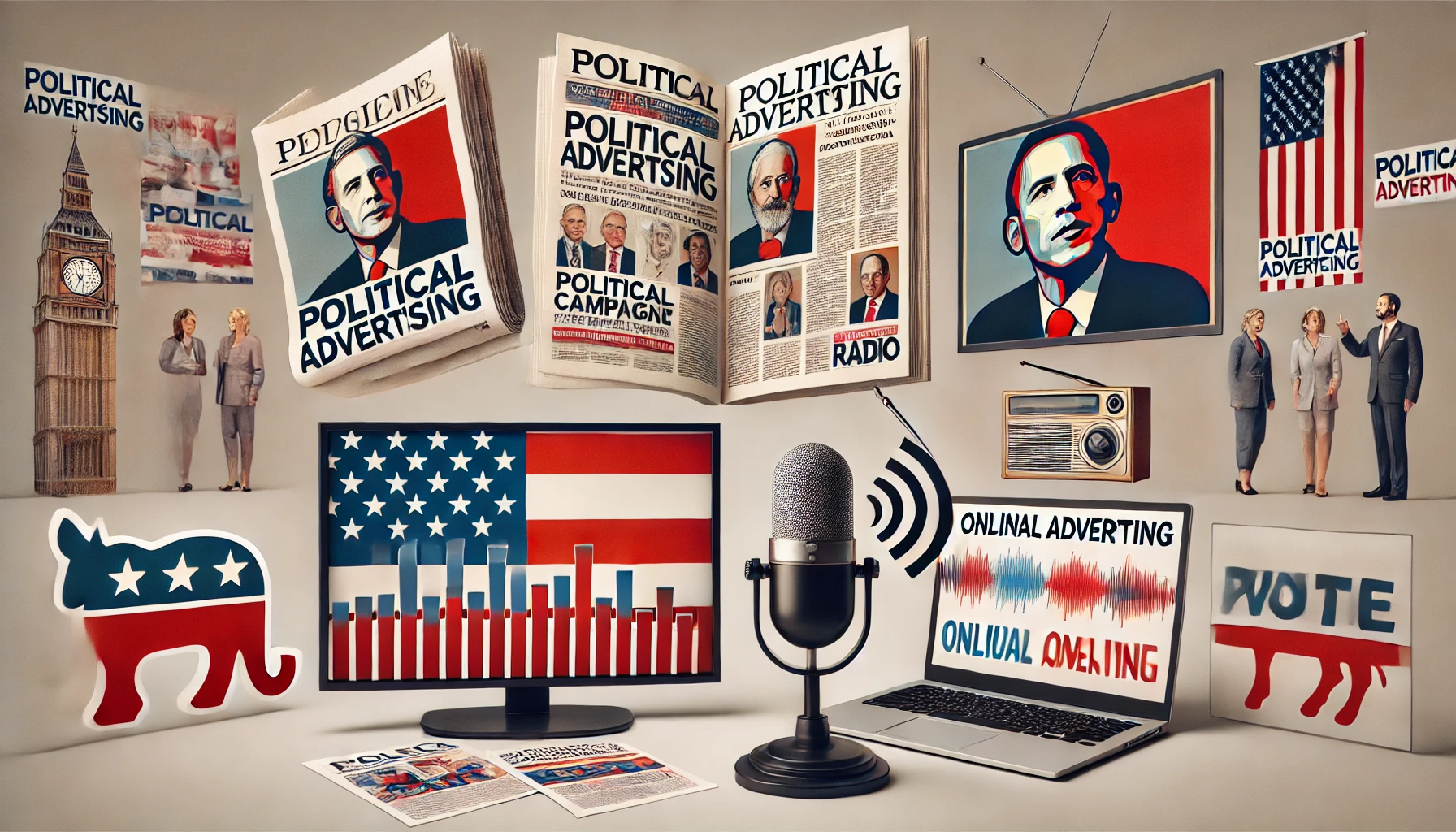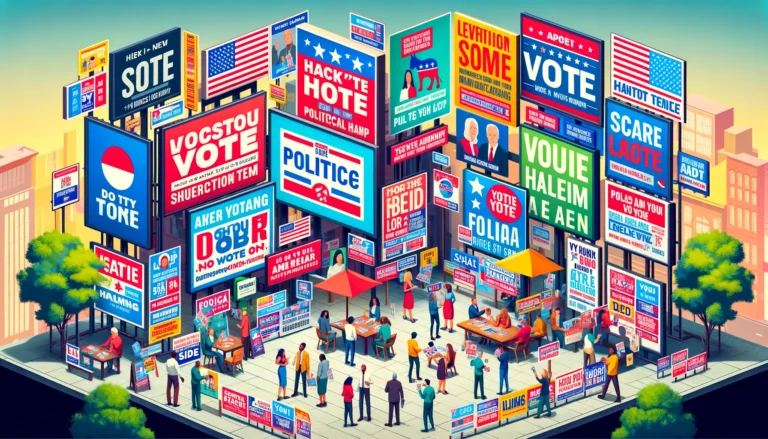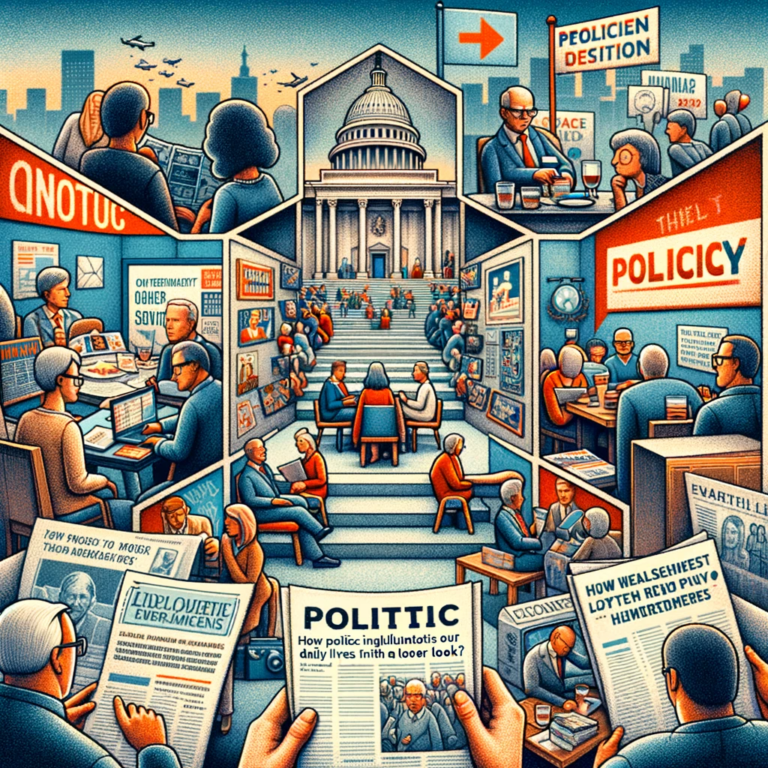Types of Political Advertising: Print, TV, Radio, and Online
Political advertising is a critical tool for candidates and political parties to communicate their messages to voters. With various mediums available, each type of political advertising has its unique advantages and challenges. In this article, we will explore the different types of political advertising—print, TV, radio, and online—and provide insights into their effectiveness. Understanding these types will help you better comprehend how political messages are crafted and disseminated.
The Importance of Political Advertising
Political advertising plays a vital role in shaping public opinion and influencing voter behavior. It allows candidates to reach a broad audience, present their policies, and counter opponents’ messages. By leveraging different advertising mediums, political campaigns can tailor their strategies to maximize impact and engagement.
Print Advertising
Historical Significance and Current Use
Print advertising, one of the oldest forms of political advertising, includes newspapers, magazines, brochures, and flyers. Historically, print media was the primary way to reach voters, offering a tangible and credible source of information.
Advantages of Print Advertising
- Credibility: Print media is often perceived as more credible and trustworthy compared to digital sources.
- Targeted Reach: Newspapers and magazines can target specific demographics, making it easier to reach a particular voter base.
- Longevity: Printed materials can be kept and referred to multiple times, ensuring the message stays with the audience longer.
Challenges of Print Advertising
- Declining Readership: With the rise of digital media, print readership has significantly decreased, limiting the reach of print ads.
- Cost: High-quality print advertising can be expensive, especially in prominent publications.
- Lead Time: Print ads require more time to design, produce, and distribute compared to digital formats.
TV Advertising
The Power of Visual and Audio Elements
Television remains a powerful medium for political advertising due to its combination of visual and audio elements. TV ads can emotionally engage viewers and leave a lasting impression.
Advantages of TV Advertising
- Wide Reach: TV ads can reach millions of viewers, making them ideal for national campaigns.
- Emotional Impact: The combination of visuals, sound, and storytelling can create a strong emotional connection with viewers.
- Controlled Messaging: Campaigns can carefully craft their messages and control how they are presented to the audience.
Challenges of TV Advertising
- High Costs: Producing and airing TV ads, especially during prime time, can be prohibitively expensive.
- Ad Skipping: With the rise of DVRs and streaming services, many viewers skip commercials, reducing the ads’ effectiveness.
- Short Attention Span: TV ads are usually brief, requiring concise and impactful messaging.
Radio Advertising
The Reach of Audio-Only Media
Radio advertising is a cost-effective way to reach a broad audience, particularly in local markets. Despite being audio-only, radio ads can be highly effective in delivering political messages.
Advantages of Radio Advertising
- Cost-Effective: Radio ads are generally less expensive to produce and air than TV ads.
- Targeted Demographics: Radio stations often cater to specific audiences, allowing campaigns to target their messages more effectively.
- Immediacy: Radio ads can be produced and aired quickly, making them suitable for timely messages or responses to current events.
Challenges of Radio Advertising
- Limited Engagement: Without visual elements, radio ads rely solely on audio to capture attention, which can be challenging.
- Background Noise: Many people listen to the radio while doing other activities, which may distract them from fully absorbing the message.
- Competition for Attention: Radio listeners often switch stations during ads, reducing the overall impact.
Online Advertising
The Digital Frontier
Online advertising has revolutionized political campaigns by providing unprecedented reach and targeting capabilities. Digital platforms like social media, websites, and search engines offer diverse ways to engage voters.
Advantages of Online Advertising
- Precise Targeting: Digital ads can be targeted based on demographics, interests, behaviors, and geographic locations.
- Interactive Content: Online ads can include interactive elements such as videos, polls, and clickable links, enhancing engagement.
- Measurable Results: Digital platforms offer robust analytics, allowing campaigns to track the performance and effectiveness of their ads in real time.
Challenges of Online Advertising
- Ad Blockers: Many users employ ad blockers, which can reduce the visibility of online ads.
- Information Overload: The vast amount of online content means political ads must compete for attention in a crowded space.
- Misinformation Risks: The digital landscape is prone to misinformation and fake news, which can complicate political messaging.
Maximizing Online Political Advertising
In today’s digital age, online political advertising has become indispensable for reaching voters. To maximize the effectiveness of online ads, campaigns should focus on SEO (Search Engine Optimization) strategies. By optimizing their content for search engines, political campaigns can ensure their messages appear prominently in search results, increasing visibility and engagement.
Essential Strategies for Political Advertising
- Keyword Research: Identify and use relevant keywords that voters are likely to search for. This includes terms related to the candidate, issues, and local concerns.
- Quality Content: Produce high-quality, informative content that addresses voter concerns and provides clear, concise information about the candidate’s platform.
- Link Building: Establish a network of backlinks from reputable websites to enhance the credibility and visibility of the campaign’s online presence.
- Mobile Optimization: Ensure all online content is optimized for mobile devices, as a significant portion of users access the internet via smartphones and tablets.
- Social Media Integration: Leverage social media platforms to amplify the reach of online ads and engage directly with voters through comments, shares, and likes.
Examples and Tips for Effective Political Advertising
Print Advertising Tips
- Use Eye-Catching Headlines: Grab the reader’s attention with bold, compelling headlines.
- Include High-Quality Images: Visuals can enhance the appeal and effectiveness of print ads.
- Focus on Local Issues: Tailor the message to address local concerns and resonate with the community.
TV Advertising Tips
- Craft a Strong Narrative: Tell a compelling story that emotionally connects with viewers.
- Keep It Simple: Deliver a clear, concise message that viewers can easily understand and remember.
- Use Testimonials: Feature endorsements from trusted figures or satisfied voters to build credibility.
Radio Advertising Tips
- Repeat Key Messages: Reinforce important points through repetition to ensure they stick with listeners.
- Use a Memorable Jingle: A catchy jingle can make the ad more memorable and engaging.
- Leverage Local Voices: Use local accents or well-known local figures to build a connection with the audience.
Online Advertising Tips
- Create Shareable Content: Design ads that are easy to share on social media to increase reach and engagement.
- Utilize Video: Video content is highly engaging and can effectively convey complex messages.
- Engage with Comments: Actively respond to comments and engage with voters to build a sense of community and trust.
Conclusion
Understanding the different types of political advertising—print, TV, radio, and online—is essential for any political campaign aiming to reach and influence voters effectively. Each medium offers unique advantages and challenges, and successful campaigns often use a mix of these strategies to maximize their impact. By leveraging the strengths of each type of advertising and implementing best practices, political campaigns can effectively communicate their messages and achieve their goals.
Political advertising remains a dynamic and evolving field. As new technologies and platforms emerge, campaigns must adapt and innovate to stay ahead. Whether through traditional print media or cutting-edge online ads, the core objective remains the same: to connect with voters and win their support.
By understanding the nuances of each advertising medium, you can better appreciate the strategies behind political campaigns and become a more informed voter. So, next time you see a political ad, take a moment to consider the thought and effort that went into crafting that message and how it aims to influence your vote.






